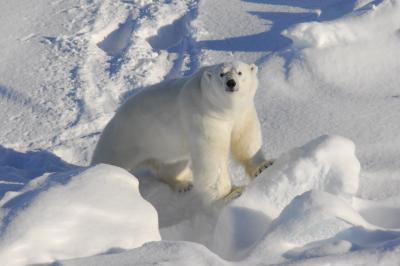A comparison of the genomes of polar bears and brown bears reveals that the polar bear is a much younger species than previously believed, having diverged from brown bears less than 500,000 years ago.
That's interesting, but incremental, like discovering Earth is 10 million years older than we thought. What is more interesting is the discovery of genes that have allowed them to live in a high-fat diet. Literal high-fat, as in blubber. With no heart disease.
People who talk about going back to our ancient diet are always endorsing artisan meats or ornate vegetarian cuisine. In reality, man's ancient diet was incredibly high-fat. People were dense to survive harsh climates and they needed calorically dense diets.
It isn't just exercise or the cold that keeps polar bears from getting fatty plaques in their arteries or the cardiovascular diseases that afflict humans It's genes, and it may help humans too.

Polar bear in March 2011 on Kap Tobin, Scoresby Sound, Central
East Greenland. Photo by Rune Dietz, Aarhus University
"For polar bears, profound obesity is a benign state," said Eske Willerslev, one of the lead authors and a U.C. Berkeley postdoctoral fellow. "We wanted to understand how they are able to cope with that."
"The promise of comparative genomics is that we learn how other organisms deal with conditions that we also are exposed to," said Rasmus Nielsen, a U.C. Berkeley professor of integrative biology and of statistics. "For example, polar bears have adapted genetically to a high fat diet that many people now impose on themselves. If we learn a bit about the genes that allows them to deal with that, perhaps that will give us tools to modulate human physiology down the line."
Close cousins
The genome analysis comes at a time when the polar bear population worldwide, estimated at between 20,000 and 25,000, is declining and its habitat, Arctic sea ice, is rapidly disappearing. As the northern latitudes warm, the polar bear's distant cousin, the brown or grizzly bear (Ursus arctos), is moving farther north and occasionally interbreeding with the polar bear (Ursus maritimus) to produce hybrids dubbed pizzlies.
Their ability to interbreed is a result of this very close relationship, Nielsen said, which is one-tenth the evolutionary distance between chimpanzees and humans. Previous estimates of the divergence time between polar bears and brown bears ranged from 600,000 to 5 million years ago.
"It's really surprising that the divergence time is so short. All the unique adaptations polar bears have to the arctic environment must have evolved in a very short amount of time," he said. These adaptations include not only a change from brown to white fur and development of a sleeker body, but big physiological and metabolic changes as well. "There has been a lot of debate about it, but I think we really nailed down what the divergence time is between them, and it is surprisingly recent."
Genetic changes affect fat metabolism
The genome comparison reveals that over several hundred thousand years, natural selection drove major changes in genes related to fat transport in the blood and fatty acid metabolism. One of the most strongly selected genes is APOB, which in mammals encodes the main protein in LDL (low density lipoprotein), known widely as "bad" cholesterol.
Changes or mutations in this gene reflect the critical nature of fat in the polar bear diet and the animal's need to deal with high blood levels of glucose and triglycerides, in particular cholesterol, which would be dangerous in humans. Fat comprises up to half the weight of a polar bear.
"The life of a polar bear revolves around fat," co-author Eline Lorenzen
said. "Nursing cubs rely on milk that can be up to 30 percent fat and adults eat primarily blubber of marine mammal prey. Polar bears have large fat deposits under their skin and, because they essentially live in a polar desert and don't have access to fresh water for most of the year, rely on metabolic water, which is a byproduct of the breakdown of fat."
She noted that the evolution of a new metabolism to deal with high dietary fat must have happened very quickly, in just a few hundred thousand years, because we know that polar bears already subsisted on a marine diet 100,000 years ago.
What drove the evolution of polar bears is unclear, though the split from brown bears (dated at 343,000–479,000 years ago) coincides with a particularly warm 50,000-year interglacial period known as Marine Isotope Stage 11.
Environmental shifts following climate changes could have encouraged brown bears to extend their range much farther north. When the warm interlude ended and a glacial cold period set in, a pocket of brown bears may have become isolated and forced to adapt rapidly to new conditions.
Samples from all over Arctic
The analysis included blood and tissue samples from 79 Greenlandic polar bears and 10 brown bears from Sweden, Finland, Glacier National Park in Alaska and the Admiralty, Baranof, and Chichagof (ABC) Islands off the Alaskan coast.
According to Lorenzen, the "key that allowed us to unlock the door of polar bear evolution" was a method devised by UC Berkeley mathematics graduate student Kelley Harris that has been used to estimate human demographic history.
The approach, referred to as the identity by state (IBS) tract method, has proved powerful in estimating when ancient human populations diverged, their past population sizes and when and how much they interbred.
Source: University of California - Berkeley





Comments